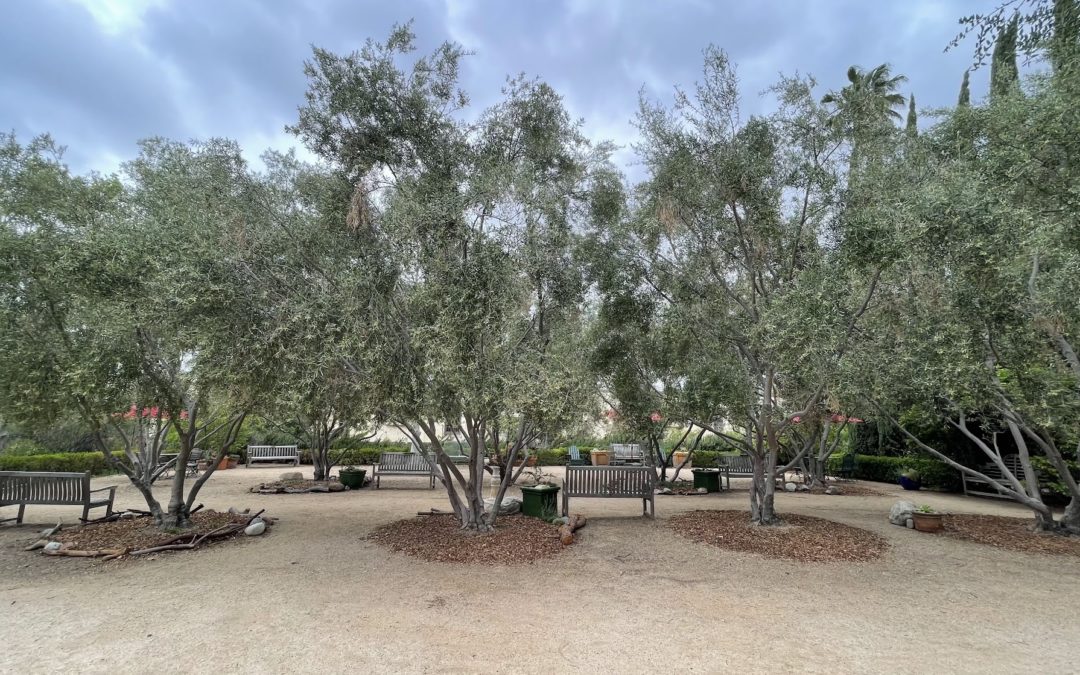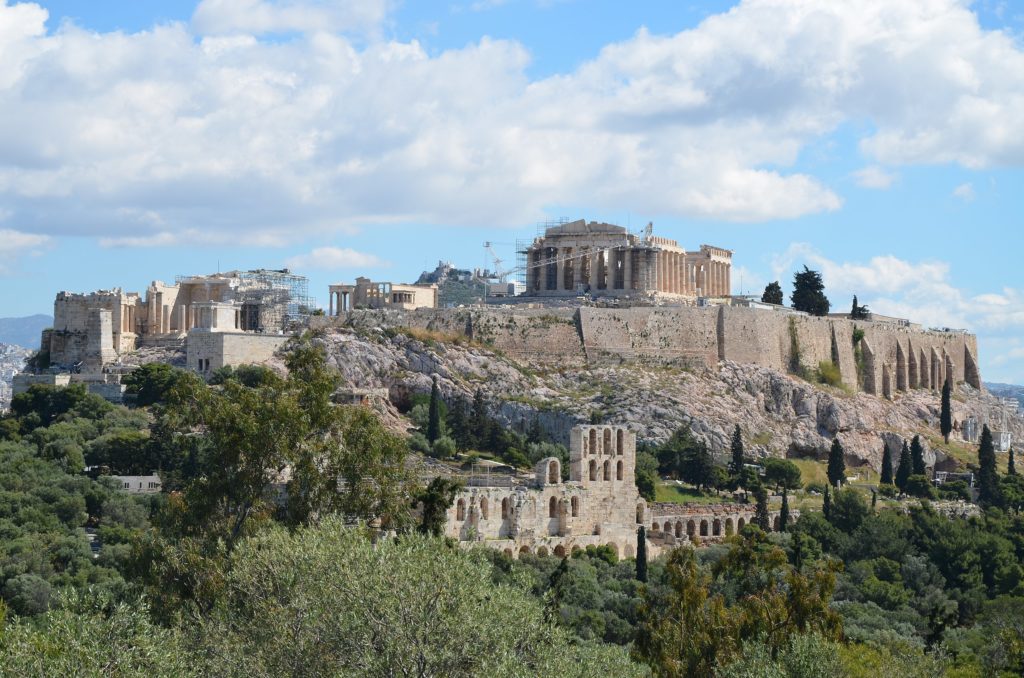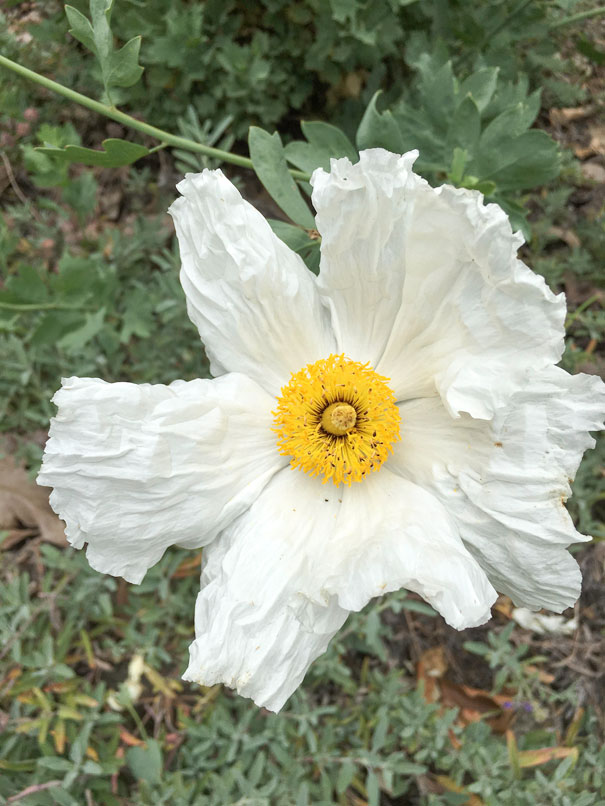Arlington, Overworld is a monthly series devoted to the ecology, history, horticulture, and biology of plants in Arlington Garden. The “overworld” is the highest-level map of a videogame showing mountains, forests, kingdoms, dungeons, and treacherous wastes. Not part of normal gameplay, the overworld facilitates progression from level to level — A.J. Jewell.
Fruitless olive: Olea europaea ‘Wilsonii’
Origin: Mediterranean Basin
Mature height and width: 25-35 ft. tall with canopy up to 30 ft. wide
Gardening notes: requires supplemental water when young, tolerant of heavy pruning and a variety of soil types, flared trunk requires space to grow (Perry 2010) but can be shaped into hedges
OLIVE TREES ARE A FAMILIAR SIGHT in the Mediterranean Basin and throughout Southern California where they are common components of residential landscaping and restaurant decor. The trunks of older specimens can look like taffy twisted up into curtains of grey-green foliage. Fruiting trees produce olives and also a gooey patina of dark fruits beneath their canopy. The cultivar grown in the olive allée – “Wilsonii” – is a so-called “fruitless” olive and is popular in landscapes where gardeners do not want a mess.
“MORIA” IS A NAME FOR A SACRED OLIVE
According to old tales of the Mediterranean Basin, the ocean god Poseidon and the parthenogenetic goddess of knowledge Athena once competed to be the patron of a famous city in Greece. In some tellings of this story, each god offered the city a token.
The author imagines that the sky was very blue and the wind was very fierce that day, since it was near the dawn of the world and nothing had yet had time to fade. Poseidon struck the earth with his trident, wounding the stone, and birthing a horse and saltwater well. The people of the city marvelled because the gift of horses (represented in that single horse) was a great gift. But Athena stepped forward and stretched out her spear to the ground. No mark was left in the stone. Yet from that spot rapidly unfurled an “olive-tree with pale trunk, thick with fruit” writes Ovid in Metamorphoses, which left “the gods marvelling.”
According to legend, the pale-trunked tree was the very first olive tree or at least the first domesticated one. What Athena offered the city was a source of oil and nutrient rich fruits: the foundation of the Mediterranean diet. As the inventor of early orchard agriculture, Athena was crowned the victor and the city of Athens became her namesake. The location of the olive tree became the future site of an acropolis: a small city of temples set above the human city.
The tree was said to still be alive in the 5th century BC by the ancient historian and travel-writer Herodotus:
“In that acropolis is a shrine of Erechtheus, called the “Earthborn,” and in the shrine are an olive tree and a pool of salt water. The story among the Athenians is that they were set there by Poseidon and Athena as tokens when they contended for the land. It happened that the olive tree was burnt by the barbarians with the rest of the sacred precinct, but on the day after its burning, when the Athenians ordered by the king to sacrifice went up to the sacred precinct, they saw a shoot of about a cubit’s length sprung from the stump …” [Herodotus, Histories, 8.55]
Popular travel websites attest that there is still an olive tree in the Acropolis today, and – in particular – a tree still growing next to the temple once dedicated to Erechtheus. Some say that this tree is a clone of the original gift from Athena. According to this tale, over the centuries, as the tree in the acropolis was damaged or grew feeble, a branch or cutting was always saved and rerooted, preserving the genetic line through a sequence of identical clones, each tree dying in turn, but the gift living on.
CLONES & CULTIVARS
The trees in the olive allee are a “fruitless” cultivar of Olea europaea. The description is not quite accurate, since the cultivar is not entirely without fruit; if you are at the garden in the Fall, you will definitely find a few mature olives hidden higgledy-piggledy amongst the branches.
Although it does produce occasional mature fruits, horticultural inventions (“cultivars”) like “Wilsonii” are usually not propagated by seed. Cultivars like this are usually created when a grower identifies a desirable genetic mutation (in this case, extremely reduced fruit production) and preserves the mutation by cutting off branches or shoots from the original plant and rooting or grafting them. These techniques have the effect of cloning the original plant.
The “cuttings” eventually mature into normal-looking trees that contain the same genetic material as the host and are propagated, in turn, by similar sorts of “low-tech” cloning techniques. Similar, in fact, to the legendary tree of Athena and even to parthenogenetic Athena herself: like all offspring of parthenogenesis, she is at least a partial clone of her parent Zeus.
Select Additional References
Donald, Isabelle. Athena and Poseidon: The Contest for Athens. Diss. Alberta (1996).
Perry, Robert. Landscape Plants for California Gardens. Land Design Pub., Los Angeles (2010).
Image of the Acropolis from Carole Raddato from Frankfurt, Germany CC BY-SA 2.0





Recent Comments